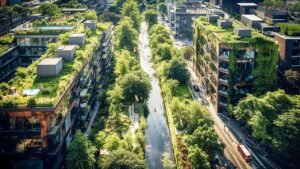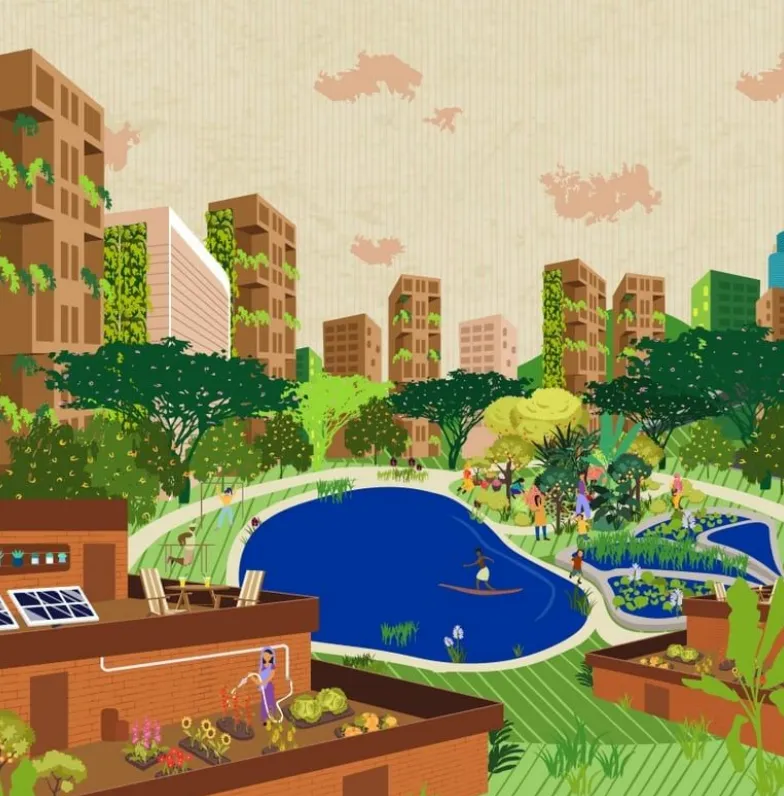Cities around the globe are facing temperatures increasing as a result of climate change and rapid urban development.
In this scenario, Green-Blue-Grey Infrastructure (GBGI) has been identified as the most effective approach for urban cooling, as highlighted in a pioneering study published in ‘The Innovation’.
This research emphasizes that GBGI, which includes features such as botanical gardens, wetlands, green walls, street trees, and vegetated balconies, can substantially lower urban heat levels while also providing various environmental advantages.
This article examines the study’s conclusions, investigates regional differences in GBGI research, and addresses the co-benefits and challenges associated with the implementation of these strategies.
By the conclusion, readers will gain insight into why Green-Blue-Grey Infrastructure represents a transformative opportunity for sustainable urban development.
Understanding Green-Blue-Grey Infrastructure (GBGI)
Green-Blue-Grey Infrastructure (GBGI) encompasses a blend of natural and engineered systems aimed at tackling urban environmental issues.
Green infrastructure consists of vegetation-based solutions such as parks and street trees, blue infrastructure pertains to water-related systems like wetlands and ponds, and gray infrastructure includes human-made constructs like green walls and roofs.
Collectively, these components offer a comprehensive strategy for urban cooling and sustainability. The study reviewed 27,486 papers and conducted a thorough analysis of 202 studies, investigating 51 types of GBGI classified into ten overarching categories.
The results indicated that GBGI not only alleviates urban heat but also delivers additional benefits such as stormwater management, flood mitigation, and carbon dioxide sequestration.
The Mechanisms of GBGI’s Cooling Impact
Urban heat islands (UHIs) arise when urban areas exhibit elevated temperatures compared to adjacent rural regions, primarily due to human activities and built environments. Green-Blue-Grey Infrastructure effectively mitigates this issue through three key processes:
- Shade Provision: The presence of trees and green roofs offers shade, leading to a decrease in surface temperatures.
- Evapotranspiration: Vegetation releases water vapor, which contributes to cooling the surrounding atmosphere.
- Thermal Insulation: Green walls and roofs serve as insulators, minimizing heat transfer into buildings.
These processes work in concert to lower urban temperatures, enhancing the livability of cities and decreasing energy demands in structures.
Regional Disparities in GBGI Research
The analysis identified notable regional variations in the research and application of GBGI. Below is a summary categorized by continent:
Asia: Pioneering GBGI Research
Asia represents 51.1% of the total global GBGI studies, with China contributing 29.95%. The predominant areas of research in this region are wetlands (14.7%) and parks (12.9%).
These results indicate Asia’s commitment to large-scale, nature-based strategies aimed at mitigating urban heat.
Europe: Emphasizing Street Trees and Green Walls
In Europe, 30.4% of GBGI research is dedicated to street trees (18.8%), green walls (15.9%), and green roofs (13.0%).
These approaches are well-suited to Europe’s densely populated urban environments, reflecting a strong emphasis on integrating greenery into existing structures.
Australia: Concentrating on Green Walls and Backyard Irrigation h4
Australia’s GBGI research is primarily focused on green walls (17.6%) and backyard irrigation systems.
When combined with studies on parks, street trees, and green roofs, these elements constitute 58.8% of the region’s GBGI research efforts.
North America: Parks and Street Trees as Key Focus Areas
In North America, the primary areas of study include parks (31.3%), street trees (18.8%), and wetlands (12.5%), which together represent 62.5% of the research.
This trend underscores the region’s inclination towards solutions that are accessible and community-oriented.
Minimal Research in South America, Africa, and New Zealand
Both South America and Africa contribute only 1.8% of GBGI studies, while New Zealand’s contribution is a mere 0.4%.
This significant gap highlights the urgent need for enhanced research and investment in these areas to effectively tackle urban heat issues.

Co-Benefits of Green-Blue-Grey Infrastructure
In addition to providing cooling effects, Green-Blue-Grey Infrastructure presents a variety of co-benefits that contribute to urban sustainability:
- Stormwater Management: Wetlands and green roofs effectively absorb rainfall, thereby decreasing runoff and the likelihood of flooding.
- Flood Mitigation: Blue infrastructure, such as ponds and retention basins, plays a crucial role in reducing flood risks.
- Carbon Sequestration: Trees and vegetation capture carbon dioxide, helping in the fight against climate change.
- Support for Biodiversity: GBGI fosters habitats for various wildlife species, enhancing urban biodiversity.
These advantages position GBGI as a comprehensive solution for cities striving to enhance their resilience to climate change.
Challenges and Drawbacks of GBGI
Despite the numerous benefits associated with Green-Blue-Grey Infrastructure, it also faces several challenges:
- Elevated Maintenance Costs: The upkeep of GBGI can be significant, potentially placing a burden on municipal finances.
- Conflicts in Land Use: The integration of GBGI in densely populated regions can be problematic due to limited space.
- Accumulation of Pollutants: Urban canyons with street trees and green walls may trap pollutants, which can negatively impact air quality.
- Health Issues: Certain elements of GBGI, such as street trees, may worsen allergic rhinitis for sensitive individuals.
In light of these challenges, the study underscores the necessity of a balanced strategy for the implementation of GBGI, ensuring that the benefits surpass the associated difficulties.
The Importance of GBGI in Future Urban Development h2
As urban areas increasingly confront the challenges posed by extreme heatwaves, the urgency for effective heat mitigation strategies has reached a critical point.
This study presents a thorough inventory of heat mitigation strategies designed to assist policymakers and urban planners in identifying the most appropriate GBGI interventions for their specific regions. Essential Recommendations for Policymakers:
Focus on High-Impact Solutions: Implementing street trees, green roofs, and botanical gardens yields significant cooling effects and climate adaptation advantages.
Customize to Local Contexts: Adapt GBGI strategies to align with regional climate conditions, urban environments, and community requirements.
Enhance Research and Development: Allocate more resources for GBGI research, especially in less-studied areas such as Africa and South America.
Foster Public Awareness: Inform communities about the advantages of GBGI to build support for its implementation.
Expert Editorial Comment
Green-Blue-Grey Infrastructure signifies a groundbreaking method for urban cooling and sustainability.
By merging natural and engineered systems, cities can effectively address urban heat, lower energy consumption, and improve resilience to climate change.
Nevertheless, successful execution necessitates meticulous planning, regional customization, and continuous research.
As global temperatures rise and urbanization continues, Green-Blue-Grey Infrastructure stands as a promising solution for developing cooler, greener, and more livable urban environments.
It is imperative for policymakers, urban planners, and communities to collaborate in maximizing the potential of GBGI to create a sustainable future for everyone.

